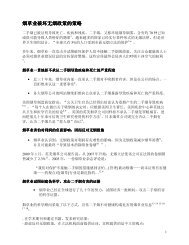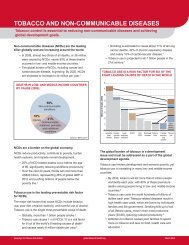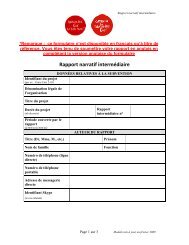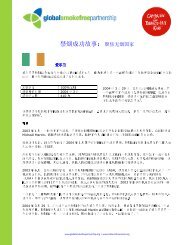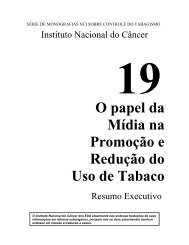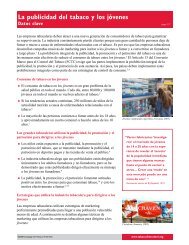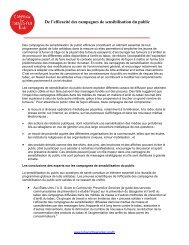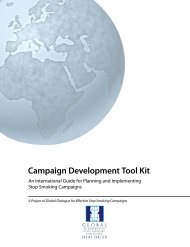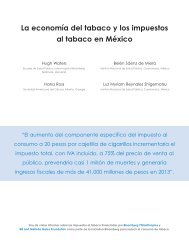India: The Tax Treatment of Bidis - Campaign for Tobacco-Free Kids
India: The Tax Treatment of Bidis - Campaign for Tobacco-Free Kids
India: The Tax Treatment of Bidis - Campaign for Tobacco-Free Kids
You also want an ePaper? Increase the reach of your titles
YUMPU automatically turns print PDFs into web optimized ePapers that Google loves.
P r o f e s s o rS i r J o h n C r o f t o nDear Colleague:<strong>Tobacco</strong> is the world’s leading single agent <strong>of</strong> death, and <strong>India</strong> is the world’s secondlargestconsumer <strong>of</strong> tobacco. In <strong>India</strong>, bidis account <strong>for</strong> the great majority <strong>of</strong> smoked tobacco,and they are no less harmful than cigarettes. Having worked at intervals in <strong>India</strong> and with many<strong>India</strong>n colleagues <strong>for</strong> more than 50 years, I remain deeply concerned about the current andgrowing epidemic <strong>of</strong> illness and death from tobacco, including from bidis.<strong>The</strong> attached report from Emil Sunley, one <strong>of</strong> the world’s leading experts on tobaccotaxation, shows not only that taxes on bidis should increase, but also lays out a rational, detailedplan <strong>for</strong> how to do so. Sunley’s conclusions are clear:• On a per-stick basis, bidis are at least as harmful as cigarettes, but the excise on bidis isonly 8% that <strong>of</strong> the most similar type <strong>of</strong> cigarettes, and less than 1% that <strong>of</strong> standardcigarettes.• Excise duty accounts <strong>for</strong> only 9% <strong>of</strong> the retail price <strong>of</strong> bidis; the recommendedinternational benchmark <strong>for</strong> taxation from a health point <strong>of</strong> view is 70% or higher.• Between half and three quarters <strong>of</strong> all bidis are completely untaxed, either because <strong>of</strong>exemptions or tax evasion.Sunley’s recommendations are equally clear. To rationalize taxation and protect health,policymakers should:• In the immediate term, increase the excise rate on bidis from Rs 14 to at least Rs 168per 1,000 sticks – resulting in a tax rate identical to that <strong>of</strong> the most similar type <strong>of</strong>cigarette.• Improve tax collection by abolishing the distinction between handmade and machinemadebidis, limiting tax exemptions to only truly small producers or eliminating theseexemptions entirely, requiring bidi tobacco sellers to report sales to manufacturers ortheir representatives, and requiring bidi manufacturers to report all tobacco purchases.Another important opportunity described in the report is the planned introduction <strong>of</strong> anational goods and services tax (GST) in 2010 in <strong>India</strong>. This provides a unique opportunity torationalize and simplify the tax treatment <strong>of</strong> tobacco products. Under the national GST, a singleexcise tax rate <strong>for</strong> all cigarettes (initially set higher than the current rate <strong>for</strong> regular filtercigarettes) can be implemented, and over several years, the excise rate on bidis per 1,000 sticksshould be increased to the rate <strong>for</strong> all cigarettes.<strong>The</strong> consumption and participation elasticities <strong>for</strong> tobacco are well understood. Not onlycould implementation <strong>of</strong> the recommendations in this report increase government revenues <strong>for</strong>important projects, but, even more importantly, could reduce the number <strong>of</strong> smokers in <strong>India</strong> by18 million and deaths from smoking by at least 6 million. <strong>The</strong> high quality <strong>of</strong> the analysis and thepotential enormous gains outlined here strongly suggest that the report should be considered in thestrongest light during all subsequent considerations <strong>of</strong> tobacco taxation in <strong>India</strong>.Sincerely,Pr<strong>of</strong>essor Sir John Cr<strong>of</strong>tonEdinburgh, ScotlandJanuary 2008
4 | <strong>India</strong>: <strong>The</strong> <strong>Tax</strong> <strong>Treatment</strong> <strong>of</strong> <strong>Bidis</strong>Figure: <strong>The</strong> Bidi Manufacturing ProcessRaw materials<strong>Tobacco</strong>Tendu LeavesCultivated and sun dried by the farmerPlucked and sun dried by indigenous tribal people<strong>Tobacco</strong> Processor / BlenderGovernment / Department <strong>of</strong> ForestryTender processBidi Manufacturer's Representative / AgentBidi Manufacturer<strong>Tobacco</strong>, tendu leavesand threadRolling processRolling contractorRolled <strong>Bidis</strong>Sorting and roastingPackaging<strong>Tobacco</strong>, tenduleaves and threadRolled <strong>Bidis</strong>Wholesaler Wholesaler WholesalerRollersRollersRollersRetailRetailRetailRetailRetailRetailSource: Genesis Public Relations, 360 Degree Analysis <strong>of</strong>Beedi Industry, Report prepared <strong>for</strong> PMI (undated).RetailRetail
Emil M. Sunley | 5In terms <strong>of</strong> tobacco consumed, bidis command 48 percent <strong>of</strong> themarket while chewing tobacco commands 38 percent and cigarettes 14percent. 4 Thus, by weight, bidis account <strong>for</strong> 77 percent <strong>of</strong> the market <strong>for</strong>bidis and cigarettes (i.e., the market <strong>for</strong> smoking tobacco).Although there are no specific figures <strong>of</strong> how many bidis are producedor consumed annually due to the fragmentation <strong>of</strong> bidi manufacturing anddistribution, estimates range from 750 billion to 1.2 trillion. In fiscal year2005/06, 106 billion cigarettes were consumed in <strong>India</strong>. 5 Thus roughly 10bidis are consumed in <strong>India</strong> <strong>for</strong> each cigarette.*Table 1: Manufacturing <strong>of</strong> <strong>Tobacco</strong> ProductsBy weight, bidis account<strong>for</strong> 77% <strong>of</strong> the market <strong>for</strong>smoking tobacco.Number <strong>of</strong> FactoriesTotal Output (Value)Rs million<strong>Bidis</strong>1991 6,983 15,9331992 7,472 16,4221993 6,847 18,5291994 4,235 21,1151995 6,693 21,281Cigarettes1991 39 8,5741992 35 9,8501993 36 12,7241994 35 13,1351995 40 15,244Chewing <strong>Tobacco</strong>1991 64 1,2281992 47 1,0461993 56 1,3481994 48 1,4881995 55 1,730Manufacturing <strong>of</strong> <strong>Tobacco</strong> Products a2000 2,643 106,4732001 2,697 119,1272002 2,477 98,5072003 2,562 122,2822004 3,078 120,752a Manufacturing <strong>of</strong> tobacco products includes bidis, cigarettes, and chewing tobacco. Data <strong>for</strong> the period2000–04 are available only at the 4-digit level (e.g., manufacturing <strong>of</strong> tobacco products) and not at the5-digit level (e.g., bidis). Source: Annual Survey <strong>of</strong> Industries.* If it is assumed that a bidi consists <strong>of</strong> 0.2 grams <strong>of</strong> tobacco and a cigarette 0.75 grams <strong>of</strong>tobacco and that 1 trillion bidis and 106 billion cigarettes were consumed in 2005/06, thenby weight bidis accounted <strong>for</strong> 72 percent <strong>of</strong> the market <strong>for</strong> smoking tobacco, which isclose to the 77 percent estimate based on tobacco consumed.
6 | <strong>India</strong>: <strong>The</strong> <strong>Tax</strong> <strong>Treatment</strong> <strong>of</strong> <strong>Bidis</strong>III. How Harmful Are <strong>Bidis</strong>?Health experts agree that all tobacco products cause disease. As acigarette consists <strong>of</strong> about 0.75 to 0.85 grams <strong>of</strong> tobacco and a bidi consists<strong>of</strong> about 0.15 to 0.25 grams <strong>of</strong> tobacco, one might assume based on theamount <strong>of</strong> tobacco in each cigarette or bidi that one cigarette is as harmfulas 4 or 5 bidis and that the tax burden, per stick, on bidis should be onequarteror one fifth that on cigarettes.Epidemiologic studies suggest that the all-cause mortality among bidismokers is at least as high as that among cigarette smokers. UsingMumbai’s voters’ list, a recent prospective cohort study — the gold standard<strong>of</strong> epidemiology — followed 99,750 individuals aged 35 or older. 6 <strong>The</strong> studyfound that the adjusted relative risk was 1.64 <strong>for</strong> men who smoked bidis and1.37 <strong>for</strong> men who smoked cigarettes, compared to 1.00 <strong>for</strong> men who neversmoked. * As the number <strong>of</strong> bidis or cigarettes smoked per day in this studywas quite low (median 5 cigarettes or 12 bidis), the higher relative risk <strong>for</strong>bidi smokers could reflect that the median bidi smoker consumed moresticks (although less tobacco) than the median cigarette smoker.To address this concern, the study compares bidi and cigarette smokerswho smoke 1–5 sticks a day and who smoke more than 5 sticks. <strong>The</strong> studyconcludes that the risk <strong>of</strong> death per stick was higher <strong>for</strong> bidis than <strong>for</strong>cigarettes. For men who smoked 1–5 bidis a day the relative risk was 1.42; <strong>for</strong>men who smoked 1–5 cigarettes, the relative risk was 1.20. ✝ If we focus onsmokers <strong>of</strong> greater than 5 sticks a day (bidis or cigarettes), the findings arequite robust. For men who smoked 6–10 bidis the relative risk was 1.56,while <strong>for</strong> men who smoked 6 or more cigarettes (including those with a packa day plus habits) the relative risk was 1.50. This supports the conclusion thatbidis are at least as dangerous as cigarettes per stick, if not more so.All-cause mortalityamong bidi smokers is atleast as high as thatamong cigarettesmokers….bidis are atleast as dangerous ascigarettes per stick, if notmore so.Why might bidis be more harmful if they contain less tobacco per stick?One possibility is that bidis are self-extinguishing, and thus the bidi smokermust suck harder to keep the bidi lit, bringing more smoke deeper into thelungs. One health study found that bidis contain two to three times the tarand nicotine as regular cigarettes. In this study, smoke from regularcigarettes and bidis was given to Swiss albino mice. Bidi smoke reliablycaused cancer in doses small enough that regular cigarette smoke in thesame doses left the mice apparently healthy. 7 That bidis contain higherlevels <strong>of</strong> nicotine and tar is indirectly admitted in the advertising <strong>of</strong> a majorbidi manufacturer who proclaims that a bidi lasts about 8–10 puffs and* <strong>The</strong> 95% confidence interval was 1.47–1.81 <strong>for</strong> bidi smokers and 1.23–1.53 <strong>for</strong> cigarettesmokers. <strong>The</strong> confidence intervals obviously overlap.✝ <strong>The</strong> 95% confidence interval was 1.20–1.68 <strong>for</strong> bidi smokers who smoked 1–5 sticks and1.02–1.42 <strong>for</strong> cigarette smokers who smoked 1–5 sticks.
Emil M. Sunley | 7gives a complete smoking satisfaction while a cigarette lasts 15–20 puffsbe<strong>for</strong>e giving the same level <strong>of</strong> satisfaction. 8One health study foundthat bidis contain 2 to 3times the tar and nicotineas regular cigarettes.IV. Overview <strong>of</strong> Rates, Revenue, <strong>Tax</strong> Burden andConsumptionThis section outlines some basic facts regarding the taxation andconsumption <strong>of</strong> bidis and cigarettes. Section VI takes up various policyissues raised by these facts.Excise rates on bidis and cigarettes<strong>India</strong> imposes specific excises (per 1,000 sticks) on both bidis andcigarettes. For bidis, the rates depend on whether the bidis are handmade*or machine-made (Table 2). <strong>The</strong> excise rates on bidis were not increased <strong>for</strong>Table 2: Excise Duty Rates on <strong>Bidis</strong>, 1993/94–2007/08(Rs per 1,000 bidis)Year Handmade Machine-made Handmade Machine-madeCurrent Rupees2007/08 Rupees a1996/97 5.5 11.6 10.1 21.21997/98 6.5 15.5 10.9 25.91998/99 6.5 15.5 10.2 24.31999/00 6.5 15.5 9.0 21.52000/01 8.0 17.0 10.7 22.82001/02 9.0 19.0 11.6 24.52002/03 9.0 19.0 11.1 23.52003/04 9.0 19.0 10.7 22.62004/05 9.0 19.0 10.3 21.72005/06 9.0 19.0 9.9 20.92006/07 12.0 22.0 12.7 23.32007/08 14.0 26.0 14.0 26.0a Calculated based on CPI year-over-year percent change <strong>for</strong> industrial workers (2001 weights)Source: Department <strong>of</strong> Revenue, Ministry <strong>of</strong> Finance, International Monetary Fund* To be more specific, the lower rate is <strong>for</strong> bidis, other than paper rolled bidis,manufactured without the aid <strong>of</strong> machines.
8 | <strong>India</strong>: <strong>The</strong> <strong>Tax</strong> <strong>Treatment</strong> <strong>of</strong> <strong>Bidis</strong>four years between 2002/03 and 2005/06. <strong>The</strong> rates <strong>for</strong> handmade bidiswere then increased 33 percent in 2006/07 and an additional 16 percent in2007/08.* <strong>Bidis</strong> produced by manufacturers producing less than 2 millionsticks a year without machines are exempt from the excise.Until the two recent increases in excise rates on bidis, the rates hadbarely kept pace with inflation. In terms <strong>of</strong> 2007/08 rupees, the excise rate<strong>for</strong> handmade bidis in 2005/06 (Rs 9.9 per 1,000 sticks) was lower than therate in 1996/97 (Rs 10.1 per 1,000 sticks).For cigarettes, the excise rates vary by the length <strong>of</strong> the cigarette andare higher <strong>for</strong> filter than <strong>for</strong> non-filter cigarettes (Table 3 <strong>for</strong> rates in<strong>The</strong> excise rate <strong>for</strong>handmade bidis in2005/06 was lower thanthe rate in 1996/97 (interms <strong>of</strong> 2007/08 rupees).Table 3: Excise Duty Rates on Cigarettes, 1993/94–2007/08 (Rs per 1,000 cigarettes —current rupees)Year Non-filter Non-filter Filter Filter Filter Filter≤60 mm >60–70 mm ≤70 mm >70–75 mm >75–85 mm >85 mm1993/94 120 250 330 630 850a1994/95 60 280 370 710 950 1,3501995/96 60 300 400 750 1,000 1,3501996/97 75 315 430 800 1,070 1,3501997/98 90 350 500 820 1,100 1,3501998/99 100 370 550 900 1,200 1,4701999/00 110 370 550 900 1,200 1,4702000/01 115 390 580 945 1,260 1,5452001/02 135 450 670 1,090 1,450 1,7802002/03 135 450 670 1,090 1,450 1,7802003/04 135 450 670 1,090 1,450 1,7802004/05 135 450 670 1,090 1,450 1,7802005/06 150 495 740 1,200 1,595 1,9602006/07 160 520 780 1,260 1,675 2,0602007/08 168 546 819 1,323 1,759 2,163a Rs 600 or 300 percent + Rs 20, whichever is higherSource: Department <strong>of</strong> Revenue, Ministry <strong>of</strong> Finance.* <strong>The</strong> percentage increases <strong>for</strong> machine-made bidis were 16 percent in 2006/07 and 18percent in 2007/08.
Emil M. Sunley | 9Handmade bidis account<strong>for</strong> over 98 percent <strong>of</strong> themarket <strong>for</strong> bidis.nominal terms and Table 4 <strong>for</strong> rates in 2007/08 rupees). For purposes <strong>of</strong>excise taxation, the length <strong>of</strong> a filter cigarette includes the filter, which isnormally 10 mm. Thus a 70 mm filter cigarette has about the same amount<strong>of</strong> tobacco as a 60 mm non-filter cigarette.Manufacturers <strong>of</strong> bidis and cigarettes also pay an education cess* <strong>of</strong>2 percent <strong>of</strong> the excise duty and a secondary and higher education cess <strong>of</strong>1 percent <strong>of</strong> the excise duty. ✝ <strong>The</strong>se levies, which raise the effective exciseburden by 3 percent, are not discussed further.Government revenueIn fiscal year 2006/07, the excises on bidis and cigarettes raised16 percent <strong>of</strong> total tax revenue and 64 percent <strong>of</strong> excise revenue. Data arenot available on the excise revenue from handmade vs. machine-made bidis,Table 4: Excise Duty Rates on Cigarettes, 1996/97–2007/08 (Rs per 1,000 cigarettes —2007/08 rupees a )Year Non-filter Non-filter Filter Filter Filter Filter≤60 mm >60–70 mm ≤70 mm >70–75 mm >75–85 mm >85 mm1996/97 137 576 786 1,463 1,957 2,4691997/98 150 585 836 1,371 1,839 2,1991998/99 156 579 861 1,409 1,878 2,3011999/00 152 512 761 1,246 1,661 2,0342000/01 154 522 777 1,265 1,687 2,0692001/02 174 580 864 1,406 1,871 2,2962002/03 167 556 828 1,347 1,792 2,2002003/04 161 535 797 1,296 1,724 2,1162004/05 154 515 766 1,247 1,659 2,0362005/06 165 545 815 1,322 1,758 2,1602006/07 170 551 827 1,336 1,776 2,1842007/08 168 546 819 1,323 1,759 2,163a Calculated based on CPI year-over-year percent change <strong>for</strong> industrial workers (2001 weights)* A cess is an earmarked tax.✝ <strong>The</strong> education cess (introduced in 2004) and the secondary and higher education cess(introduced in 2007) apply to income tax, corporation tax, customs duties, and service taxin addition to excise tax.
10 | <strong>India</strong>: <strong>The</strong> <strong>Tax</strong> <strong>Treatment</strong> <strong>of</strong> <strong>Bidis</strong>but the Department <strong>of</strong> Revenue believes that handmade bidis count <strong>for</strong> over98 percent <strong>of</strong> the market <strong>for</strong> bidis. Although 10 bidis are smoked <strong>for</strong> everycigarette, in 2006/07 bidis accounted <strong>for</strong> only 5.7 percent <strong>of</strong> the exciserevenue from bidis and cigarettes, down from 7.4 percent in 1993/94(Table 5).When excise rate on handmade bidis was increased 33 percent at thebeginning <strong>of</strong> 2006/07, excise revenue from bidis increased only 16 percent.Why was the increase so low? Part <strong>of</strong> the explanation is that there is apayment lag between when the excise liability accrues and when paymentsare received by the government. As bidi manufacturers are required to makeexcise payments only every three months, 9 the expected increase in revenuein the first financial year from a 33 percent increase in the rate would be24.75 percent — payments in the first quarter would reflect productionduring the previous financial year. That revenue increased only 16 percentwould also be due to some bidi smokers reducing consumption, switchingAlthough 10 bidis aresmoked <strong>for</strong> everycigarette, in 2006/07 bidisaccounted <strong>for</strong> only 5.7%<strong>of</strong> the excise revenuefrom bidis and cigarettes,down from 7.4% in1993/94.Table 5: Excise Revenue from <strong>Bidis</strong> and Cigarettes,1993/94–2006/07 (Rs millions)Fiscal Total <strong>Bidis</strong> Cigarettes <strong>Bidis</strong> as aYearPercent <strong>of</strong> Total1993/94 29,591 2,195 27,396 7.41994/95 29,629 2,200 27,429 7.41995/96 36,502 2,233 34,269 6.11996/97 42,242 2,415 39,827 5.71997/98 48,162 3,238 44,924 6.71998/99 49,153 3,233 45,920 6.61999/00 51,843 3,217 48,626 6.22000/01 55,343 3,538 51,805 6.42001/02 54,167 3,572 50,595 6.62002/03 55,004 3,604 51,400 6.62003/04 58,317 3,364 54,953 5.82004/05 63,431 3,482 59,949 5.52005/06 74,785 3,680 71,105 4.92006/07 75,119 4,262 70,857 5.7Source: Department <strong>of</strong> Revenue, Ministry <strong>of</strong> Finance.
Emil M. Sunley | 11Establishing the same persticktax <strong>for</strong> bidis as <strong>for</strong>cigarettes would requirethe rate <strong>for</strong> bidis toincrease from Rs 14 per1,000 to at least Rs 168 per1,000, which is the currentrate <strong>for</strong> micro non-filtercigarettes.from taxed to untaxed bidis, or switching to the lower-priced cigarettes.<strong>The</strong>re also would be some increase in tax evasion; that is, bidimanufacturers underreporting production. Steps to improve compliance arediscussed in Section VI.Excise burden — bidis vs. cigarettesBy any measure, per gram <strong>of</strong> tobacco per stick, or relative to the retailprice, bidis are under-taxed relative to cigarettes. <strong>The</strong> excise burden onbidis is Rs 0.07 per gram compared to Rs 0.22 per gram <strong>for</strong> micro non-filtercigarettes, which are low-priced cigarettes aimed at the low-income segment<strong>of</strong> the market, and Rs 1.092 <strong>for</strong> regular filter cigarettes, which are the mostpopular category <strong>of</strong> cigarettes (Table 6). Thus, per gram <strong>of</strong> tobacco,handmade bidis have only one-third the excise burden <strong>of</strong> micro non-filtercigarettes, which in turn have only one fifth <strong>of</strong> the burden <strong>of</strong> regular filtercigarettes.Given that the epidemiologic studies indicate that bidis are at least asharmful as cigarettes per stick, the under-taxation <strong>of</strong> bidis is even greater.Establishing the same per-stick tax <strong>for</strong> bidis as <strong>for</strong> cigarettes would requirethe rate <strong>for</strong> bidis to increase from Rs 14 per 1,000 to at least Rs 168 per1,000, which is the current rate <strong>for</strong> micro non-filter cigarettes (Table 7).*Table 6: Excise Burden per Unit <strong>of</strong> <strong>Tobacco</strong>, 2007/08Category Grams <strong>of</strong> <strong>Tobacco</strong> Excise Duty Excise Duty Per(per 1,000 sticks) (Rs per 1,000 sticks) Gram <strong>of</strong> <strong>Tobacco</strong>(Rs per gram)Handmade bidis 200 14 0.07Micro non-filter 750 168 0.22cigarettes(≤60 mm)Regular filter 750 819 1.092cigarettes(≤70 mm)* If the lowest taxed regular filter cigarettes were used as the new bidi benchmark (asopposed to micro non-filters cigarettes), the tax rate <strong>for</strong> bidis would increase from Rs 14per 1,000 to Rs 819 per 1,000.
12 | <strong>India</strong>: <strong>The</strong> <strong>Tax</strong> <strong>Treatment</strong> <strong>of</strong> <strong>Bidis</strong>When the excise burden is measured as a percentage <strong>of</strong> the retail price,the burden is 33 percent or higher <strong>for</strong> cigarettes but only 9 percent <strong>for</strong> bidis(Table 8).* This again suggests that bidis are under-taxed relative tocigarettes.Tables 6 and 7 overstate the true excise burden on both bidis andcigarettes because part <strong>of</strong> the excise duty is in the nature <strong>of</strong> a generalconsumption tax, as explained below. <strong>The</strong> excise duty on bidis comprisesthree elements: (i) the Central Value Added <strong>Tax</strong> (CENVAT), (ii) the NationalCalamity Contingent Duty (NCCD), and (iii) Beedi Workers’ Welfare Cess(BWWC) (Table 8). For cigarettes, the excise duty also comprises threeparts: (i) CENVAT, (ii) NCCD, and (iii) the Health Cess (HC) (Table 9).As a percentage <strong>of</strong> retailprice, the excise burden is33 percent or higher <strong>for</strong>cigarettes but only9 percent <strong>for</strong> bidis.As NCCD applies to bidis, cigarettes and other goods that are <strong>of</strong>tensubject to excise duties, it is an excise-type levy. ✝ BWWC applies only toTable 7: Excise Burden on Cigarettes and <strong>Bidis</strong>, 2007Category Most Popular Retail Price Excise Duty Excise DutyBrand Per Stick Per Stick as a Percent(Rs) (Rs) <strong>of</strong> Retail PriceCigarette filter: a>75–85 mm Four Square 3.0 1.759 58.6>70–75 mm Wills Navy Cut 3.4 1.323 37.8≤70 mm Gold Flake 2.4 0.819 34.1Cigarette non-filter:>60–70 mm Cavanders Gold Leaf 1.25 0.546 43.7≤60 mm Charminar 0.50 0.168 33.6<strong>Bidis</strong>:Handmade - 0.16 0.014 8.8aFilter cigarettes >85 mm are omitted as they constitute only a negligible share <strong>of</strong> the market.Source: Philip Morris International and author’s estimates* Within each category <strong>of</strong> cigarettes there is considerable variation in prices. Amongpremium brands (filter >70–75 mm), the price per pack <strong>of</strong> 20 is Rs 100 <strong>for</strong> <strong>India</strong> Kings, Rs 90<strong>for</strong> Marlboro, Rs 76 Gold Flake, and Rs 60 <strong>for</strong> Four Square. <strong>The</strong> most popular brand in thefilter >75–85 mm category (Four Square) is cheaper than the most popular brand in thefilter >70–75 mm category (Wills Navy Cut). According to Philip Morris International, be<strong>for</strong>eMarch 2007, the price <strong>of</strong> Four Square was Rs 58 per pack and Wills Navy Cut was Rs 54 perpack, but after the 5 percent excise increase in the 2007/08 budget, the price <strong>of</strong> FourSquare was increased to Rs 60 per pack while the price <strong>of</strong> Wills Navy Cut was increasedsharply to Rs 68 per pack.✝ Specifically, the NCCD is a surcharge by way <strong>of</strong> duty or excise levied on goods specifiedin the Seventh Schedule <strong>of</strong> the Finance Act <strong>of</strong> 2001. <strong>The</strong> goods subject to NCCD includetobacco products, petroleum products, high tenacity yarn <strong>of</strong> polyesters, and motorvehicles.
Emil M. Sunley | 13An estimated 52–70percent <strong>of</strong> all bidis do notget taxed because <strong>of</strong>non-compliance or smallproducer exemption.bidis and HC applies only to cigarettes and there<strong>for</strong>e these also are excisetype levies. CENVAT, in contrast, applies to most manufactured goods at a16 percent rate and is similar to a value-added tax that applies only throughthe manufacturing stage. However, in the case <strong>of</strong> bidis (and cigarettes) theCENVAT is a specific levy and if translated into ad valorem rate, it would bemuch higher than 16 percent. Thus part <strong>of</strong> the CENVAT levy on bidis andcigarettes is in the nature <strong>of</strong> a general consumption tax (the amount equalto 16 percent <strong>of</strong> the manufacturer’s price) and part is in the nature <strong>of</strong> anexcise (the amount in excess <strong>of</strong> 16 percent). Given the markup betweenmanufacturing and retail, a 16 percent CENVAT is roughly equivalent to a10 percent tax on retail.Table 8: Excise Duty on <strong>Bidis</strong>, 2007/08 (Rs per 1,000 sticks)Type <strong>of</strong> Bidi Total CENVAT NCCD BWWCMachine-made 26 20 2 4Handmade 14 9 1 4Source: Department <strong>of</strong> Revenue, Ministry <strong>of</strong> Finance.Table 9: Excise Duty on Cigarettes, 2007/08 (Rs per 1,000 sticks)Type <strong>of</strong> Cigarette Total CENVAT NCCD HCFilter:>85 mm 2,163 1,748 235 180>75–85 mm 1,759 1,424 190 145>70–75 mm 1,323 1,068 145 110≤70 mm 819 659 90 70Non-filter:>60 mm 546 441 60 45≤60 mm 168 133 20 15Source: Department <strong>of</strong> Revenue, Ministry <strong>of</strong> Finance.
14 | <strong>India</strong>: <strong>The</strong> <strong>Tax</strong> <strong>Treatment</strong> <strong>of</strong> <strong>Bidis</strong>If CENVAT up to 10 percent <strong>of</strong> the retail price is considered the generalconsumption tax that applies to all manufactured goods, and only theamount <strong>of</strong> CENVAT in excess <strong>of</strong> 10 percent <strong>of</strong> retail price is considered a“true” excise levy, the excise burden when measured as a percentage <strong>of</strong> theretail price would be reduced by 10 percentage points. Thus the exciseburden on bidis would be zero, and the excise on cigarettes would be 23percent <strong>of</strong> the retail price or higher.<strong>Tax</strong>-paid bidisAs indicated above, there are no specific figures on how many bidis areproduced or consumed annually — 750 billion to 1.2 trillion sticks can betaken as a rough estimate. However, given that almost all bidis arehandmade, it is possible to estimate the number <strong>of</strong> bidis that are tax-paid(Table 10). In the most recent year, it is estimated that only 360 billion bidisticks were tax-paid in 2006/07, suggesting that 52 to 70 percent <strong>of</strong> all bidisare not taxed due either to non-compliance or the small producerexemption. <strong>The</strong> number <strong>of</strong> bidis that are tax-paid has been on a downwardtrend. This may reflect a combination <strong>of</strong> deterioration in tax en<strong>for</strong>cement<strong>The</strong> excise rate on bidiscannot be considered inisolation from the exciserate on cigarettes,particularly micro nonfiltercigarettes.Table 10: <strong>Tax</strong>-Paid <strong>Bidis</strong>, 1996/97 to 2006/07Year Duty <strong>for</strong> Revenue <strong>Tax</strong>-Paid <strong>Bidis</strong> aHandmade <strong>Bidis</strong> (Rs millions) (billions <strong>of</strong> sticks)(Rs per 1,000)1996/97 5.5 2,415 4401997/98 6.5 3,238 5001998/99 6.5 3,233 5001999/00 6.5 3,217 4902000/01 8.0 3,538 4402001/02 9.0 3,572 4002002/03 9.0 3,604 4002003/04 9.0 3,364 3702004/05 9.0 3,482 3902005/06 9.0 3,680 4102006/07 12.0 4,262 360a Revenue divided by excise duty per stick.Source: Department <strong>of</strong> Revenue and author’s estimates
Emil M. Sunley | 15and/or bidi smokers upgrading to cigarettes. It could also reflect a switchfrom taxed to untaxed bidis.<strong>The</strong> major policy issuesare: (i) the distinctionbetween homemade andmachine-made bidis,(ii) the excise rate onbidis, (iii) the smallproducer exemption, and(iv) steps to improvecompliance.Cigarette consumption<strong>The</strong>re are estimates <strong>of</strong> <strong>India</strong>n cigarette consumption based onmanufacturer inquiries, the <strong>Tobacco</strong> Board <strong>of</strong> <strong>India</strong>, and production andtrade data (Table 11). Total cigarette consumption declined from a high <strong>of</strong>104 billion sticks in 1997/98 to a low <strong>of</strong> 85 billion sticks in 2001/02, butthen rose steadily to 107 billion sticks in 2006/07. <strong>The</strong> increase in cigaretteconsumption is probably largely explained by the increase in <strong>India</strong>'s realgrowth rate — growth in real per capita income accelerated beginning in2003. With rising income per capita, some bidi smokers will switch tocigarettes.*Table 11: Cigarette Consumption and Market Share, 1993/94 to 2006/07YearCigaretteConsumption(Million sticks)Market Share (in percent)Non-filter Non-filter Filter Filter Filter≤60 mm >60–70 mm ≤70 mm >70–75 mm >75–85 mm1993/94 85,623 1.0 36.0 46.0 12.0 5.01994/95 93,673 7.0 36.0 43.0 9.0 5.01995/96 100,950 18.0 28.0 41.0 8.0 5.01996/97 102,806 19.0 23.0 44.5 8.5 5.01997/98 104,142 19.4 23.0 44.0 8.2 5.41998/99 102,200 NA NA NA NA NA1999/00 98,433 11.8 22.4 49.4 10.6 5.82000/01 97,800 9.6 21.1 52.0 11.3 6.02001/02 84,580 8.5 22.6 52.0 10.7 6.22002/03 89,550 8.0 23.0 52.5 10.0 6.52003/04 93,040 7.5 23.5 53.0 9.5 6.52004/05 98,860 7.3 23.7 53.3 9.2 6.52005/06 105,530 7.0 24.0 53.5 9.0 6.52006/07 107,500 NA NA NA NA NANote: Market share not given <strong>for</strong> filter cigarettes >85 mm, as the share is de minimis. NA = Not available.Source: ERC, World Cigarettes, 2001, 2005, and 2006.* As cigarettes are <strong>of</strong>ten sold by the stick, some bidi smokers also smoke an occasionalcigarette.
16 | <strong>India</strong>: <strong>The</strong> <strong>Tax</strong> <strong>Treatment</strong> <strong>of</strong> <strong>Bidis</strong>Although the excise schedule distinguishes six categories <strong>of</strong> cigarettes— two non-filter and four filter — most cigarettes that are sold are regularfilters (60–70 mm). This suggests thatthe schedule <strong>of</strong> excise rates could be simplified and this is discussed furtherin Section VII.Prior to 1994/95, the micro non-filter cigarette (≤60 mm) commandedonly a 1 percent share <strong>of</strong> the cigarette market (Table 11). Following the 50percent reduction <strong>of</strong> the excise rate on these cigarettes in 1994/95 from Rs120 to Rs 60 per 1,000 (Table 3), market volumes <strong>for</strong> cigarettes increased asbidi smokers were won over to the cigarette market. <strong>The</strong> market share <strong>for</strong>micros rose to 19 percent by 1997/98. In recent years the market share <strong>of</strong>micro non-filter cigarettes has slipped back to 7 percent, as the excise rateon these cigarettes has risen more rapidly than the excise rate on handmadebidis. All this suggests that the excise rates on bidis cannot be setindependently <strong>of</strong> the excise rates on cigarettes, particularly the rate onmicro non-filters. Substitution between bidis and cigarettes must be takeninto account.V. Administration <strong>of</strong> Excises on <strong>Bidis</strong> andCigarettes: An IntroductionExcises are levied on the importation <strong>of</strong> excisable goods (if the goodsare imported) or on the manufacturing <strong>of</strong> excisable goods (if the goods areproduced domestically). <strong>The</strong> taxable event is importation or manufacturingand not the sale <strong>of</strong> these goods.<strong>The</strong> introduction <strong>of</strong> anational GST in 2010would provide anopportunity to simplifyand rationalize the excisetaxes on tobaccoproducts.Excises are generally administered similarly to customs duties. Ifcollected at the border, the customs procedures apply directly. If collectedon domestic production, the procedures followed are usually analogous tocustoms procedures, with the producer’s facilities being analogous to acustoms warehouse.In the case <strong>of</strong> goods that are manufactured domestically, excise duty isusually chargeable only on finished goods ready <strong>for</strong> sale to consumers.Although rolling <strong>of</strong> bidis is a manufacturing process, excise duty would notbe charged on bidi rollers, as the bidis still need to be roasted be<strong>for</strong>e theyare ready <strong>for</strong> sale to consumers. Roasting, as explained earlier, is done bythe manufacturer who also packages the bidis.One could argue that un-roasted bidis are a saleable product; theycould be dried in the sun and there<strong>for</strong>e should be subject to excise duty.
Emil M. Sunley | 17As a practical matter, it would not be possible to collect excise duty frombidi rollers.Excises on the domestic manufacturing <strong>of</strong> tobacco products normallyare comparatively easy to administer, as there are only a small number <strong>of</strong>manufacturers <strong>of</strong> tobacco products. In <strong>India</strong>, <strong>for</strong> example, there are only afew facilities <strong>for</strong> manufacturing cigarettes — 40 factories in 1995 (Table 1),which is the last year <strong>for</strong> which data are available — making theadministration <strong>of</strong> the excises on cigarettes manufactured locally relativelyeasy. Physical controls are maintained at each manufacturing facility, whichallows monitoring <strong>of</strong> what goes into the factory and what goes out. Eachconsignment <strong>of</strong> cigarettes is certified by the excise <strong>of</strong>ficer.As 98 percent <strong>of</strong> bidis arehandmade, eliminatingthe distinction betweenhandmade and machinemadebidis and taxing allbidis at a rate <strong>of</strong> Rs 14 per1,000 would havenegligible revenue effectin the short-term. Overtime, it should lead togreater use <strong>of</strong> machinesto produce bidis.In contrast to cigarettes, the manufacturing <strong>of</strong> bidis is highlyfragmented — there are thousands <strong>of</strong> bidi factories. It would not be practicalto maintain physical controls at each bidi manufacturing facility (or onsellers <strong>of</strong> tobacco used to produce bidis). (In Section VI other measures toreduce non-compliance are outlined.)Under the <strong>India</strong>n Excise Law, any person engaged in the production ormanufacturing or any process in production or manufacture <strong>of</strong> goodssubject to excise is required to register with the proper excise <strong>of</strong>ficer. 10However, if a person produces less than 2 million bidis annually, he is notrequired to register but is required to file an annual declaration.VI. Policy Issues<strong>The</strong> major policy issues relating to the tax treatment <strong>of</strong> bidis are: (i) thedistinction between homemade and machine-made bidis, (ii) the excise rateon bidis, (iii) the small producer exemption, and (iv) steps to improvecompliance. <strong>The</strong> introduction <strong>of</strong> a national GST in 2010 would provide anopportunity to simplify and rationalize the excise taxes on tobacco products,and this is discussed in Section VII.Handmade vs. machine-made<strong>India</strong> traditionally has favored small-scale manufacturing by providinglower excise duties if the goods are made without the use <strong>of</strong> a machine orpower. This has led to considerable litigation and probably has slowedinnovation. 11 <strong>The</strong>se distinctions are being abolished, but some still continue,including the lower rate <strong>for</strong> handmade bidis.
18 | <strong>India</strong>: <strong>The</strong> <strong>Tax</strong> <strong>Treatment</strong> <strong>of</strong> <strong>Bidis</strong><strong>The</strong> excise rate on bidis depends on whether they are handmade (Rs 14per 1,000) or machine-made (Rs 26 per 1,000). <strong>The</strong> use <strong>of</strong> a cutting dye bythe rollers and the use <strong>of</strong> a simple oven during the roasting process are notconsidered to be the use <strong>of</strong> a machine, which would disqualify the bidis <strong>for</strong>the lower handmade rate. However, use <strong>of</strong> a stapler <strong>for</strong> closing the packingcould lead to the excise <strong>of</strong>ficer asking <strong>for</strong> a higher rate <strong>of</strong> duty. <strong>The</strong>re hasbeen litigation as to whether handmade bidis packed with wrappers/labelswhich are manufactured with the aid <strong>of</strong> machines by job workers wouldresult in the bids being classified as machine-made bidis subject to thehigher excise rate. 12 <strong>The</strong> government lost this case, but it has now agreed t<strong>of</strong>ollow the court decision. 13As 98 percent <strong>of</strong> bidis are handmade, eliminating the distinctionbetween handmade and machine-made bidis and taxing all bidis at a rate <strong>of</strong>Rs 14 per 1,000 would have negligible revenue effect in the short-term. Overtime, it should lead to greater use <strong>of</strong> machines to produce bidis. This wouldhave two effects. First, although there would be fewer people employed inbidi manufacturing, they should be higher paid, reflecting their improvedlabor productivity. Second, bidi manufacturing would be less fragmented,making it easier to collect excise duties on manufactured bidis.Excise rate on bidisAs epidemiologic studies indicate that bidis are as or more harmfulthan cigarettes per stick, the excise rate on bidis — handmade or machinemade— should be increased to at least the rate on non-filter microcigarettes — the low-priced cigarettes most likely to be purchased by thepoor. (<strong>The</strong> final section <strong>of</strong> the paper considers a rationalization <strong>of</strong> cigaretteand bidi excises when a national GST is introduced.) Thus the rate on bidiswould be increased Rs 14 to at least Rs 168 per 1,000 sticks. If the rate onbidis were set at Rs 168 per 1,000 sticks, the average retail price <strong>of</strong> bidiswould double from about Rs 4 to Rs 8 per pack <strong>of</strong> 25 bidis.Some will argue that increases in the excise on bidis would hurt thepoor. However, if the poor bidi smoker reduces his consumption <strong>of</strong> tobacco,wouldn’t he and his family be better <strong>of</strong>f? Moreover, governments surelyhave better ways <strong>of</strong> helping the poor than providing cheap tobaccoproducts.*If the rate on bidis wereset at Rs 168 per 1,000sticks, the average retailprice <strong>of</strong> bidis woulddouble from about Rs 4 toRs 8 per pack <strong>of</strong> 25bidis….Some will arguethat increases in theexcise on bidis would hurtthe poor. However, if thepoor bidi smoker reduceshis consumption <strong>of</strong>tobacco, wouldn’t he andhis family be better <strong>of</strong>f?Moreover, governmentssurely have better ways <strong>of</strong>helping the poor thanproviding cheap tobaccoproducts.* Introduction <strong>of</strong> a national GST, discussed in the next section, will require carefulconsideration <strong>of</strong> the distributional aspects <strong>of</strong> indirect taxes, including excises on tobaccoproducts. Exempting basic (unprocessed) foods would provide better protection <strong>for</strong> thepoor than would under-taxing bidis.
Emil M. Sunley | 19Small producer exemptionExcise duty is not chargedif the manufacturerproduces less than 2million bidis in a financialyear. To produce morethan 2 million bidis in ayear requires only 6 rollersmaking 1,000 bidis a day.A high proportion <strong>of</strong> bidisthat are untaxed probablyescape taxation throughtax evasion.Excise duty is not charged if the manufacturer produces less than 2million bidis in a financial year.* To produce more than 2 million bidis in ayear requires only 6 rollers making 1,000 bidis a day. For a manufacturerthis would hardly permit economies <strong>of</strong> scale in buying tobacco and tenduleaves or in sorting, roasting and packing the bidis. Of course, some bidimanufacturers may claim they produce less than 2 million bidis a year whenthey produce much higher volumes. <strong>The</strong>re are no data available on thenumber <strong>of</strong> manufacturers who either claim or qualify <strong>for</strong> the small producerexemption.Beginning with financial year 2006/07, bidi manufacturers who wantto benefit from the small producer exemption must file an annualdeclaration giving required particulars including the quantity <strong>of</strong> bidismanufactured in the previous financial year, the details <strong>of</strong> themanufacturing processes undertaken by the manufacturer, and the details<strong>of</strong> any process <strong>of</strong> manufacture <strong>of</strong> bidis undertaken by job workers (such asrolling bidis). 14 <strong>The</strong> first declarations (<strong>for</strong> financial year 2006/07) were to befiled on or be<strong>for</strong>e March 31, 2007. It is too early to know just how manydeclarations were filed. However, if bidi manufacturers who otherwisequalify <strong>for</strong> the small producer exemption fail to file the requireddeclaration, they cannot avail themselves <strong>of</strong> the exemption. This should givethe small producers a strong incentive to file the declaration.To avoid harassment <strong>of</strong> small producers, excise <strong>of</strong>ficers are neitherpermitted to visit any manufacturer who has filed a declaration <strong>for</strong> purposes<strong>of</strong> conducting verification nor to summon him. <strong>The</strong>re is one exception tothis rule: If intelligence inputs are received that a manufacturer has filed afalse declaration, or has violated any other provision <strong>of</strong> law, thejurisdictional Commissioner <strong>of</strong> Central Excise may authorize a survey orother such action in order to detect any irregularity. 15 This rule seems to tiethe hands <strong>of</strong> the excise <strong>of</strong>ficer, but it may be needed if there is a long history<strong>of</strong> excise <strong>of</strong>ficers harassing small bidi producers.<strong>The</strong> small producer exemption is available on a per manufacturerbasis; a manufacturer may have one or more factories. <strong>The</strong> test <strong>for</strong>qualifying as a small producer, however, does not require aggregatingmanufacturers that are under common control. By setting up additionalcompanies under common control, the 2 million ceiling can be easily* Specifically the small producer exemption is <strong>for</strong> bidis, other than paper rolled bidis,manufactured without the aid <strong>of</strong> machines, by a manufacturer by whom or on whosebehalf no bidis are sold under a brand name, in respect <strong>of</strong> first clearances <strong>of</strong> such bidis<strong>for</strong> home consumption by or on behalf <strong>of</strong> such manufacturer from one or more factoriesup to a quantity not exceeding 20 lakhs (2 million) cleared on or after the 1st day <strong>of</strong> Aprilin any financial year (Item 2403 10 31 <strong>of</strong> the First Schedule to the Central Excise Tariff Act<strong>of</strong> 1985).
20 | <strong>India</strong>: <strong>The</strong> <strong>Tax</strong> <strong>Treatment</strong> <strong>of</strong> <strong>Bidis</strong>circumvented. For example, it would be possible <strong>for</strong> two or moremanufacturers under common control to share facilities.To close this loophole, a “manufacturer” <strong>for</strong> purposes <strong>of</strong> the smallproducer exemption should include all companies that are owned orcontrolled directly or indirectly by the same interests. In determiningwhether a manufacturer is a small producer, all “associated enterprises,” asdefined in the Income <strong>Tax</strong> Act, could be aggregated.* An approach thatwould be simpler than the <strong>India</strong>n definition <strong>of</strong> associated enterprises wouldbe to provide a general rule as follows: “For purposes <strong>of</strong> the small producerexemption, all entities or businesses (whether or not incorporated andwhether or not organized in <strong>India</strong>), under common ownership, would beconsidered a single manufacturer.” Common ownership would then bedefined as follows: “Two or more entities or businesses are under commonownership if the same persons own (directly or indirectly) 50 percent ormore in value <strong>of</strong> the equity interests in each such entity or business.” 16Another potential simplification would be to eliminate the small producerexemption entirely.Another potentialsimplification would be toeliminate the smallproducer exemptionentirely.<strong>Tax</strong> complianceA high proportion <strong>of</strong> bidis that are untaxed probably escape taxationthrough tax evasion. Bidi manufacturers simply underreport their sales. Asmost bidi manufacturers are closely held private companies that do notneed to report to public shareholders or to banks, it is quite easy to keeptwo sets <strong>of</strong> books or possibly no books at all.Although very little comparative data on tax non-compliance areavailable, 52 to 70 percent non-compliance probably is not out <strong>of</strong> line withinternational experience. <strong>The</strong> US Internal Revenue Service, which probablydoes the best job in developing reliable estimates <strong>of</strong> non-compliance,estimates that non-compliance is 1 percent <strong>for</strong> wages (subject towithholding) and 4 percent <strong>for</strong> interest and dividend income (subject toin<strong>for</strong>mation reporting), but 57 percent <strong>for</strong> non-farm proprietor income, 72percent <strong>for</strong> farm income, and 51 percent <strong>for</strong> rents and royalties (all <strong>of</strong> whichare not subject to withholding or in<strong>for</strong>mation reporting). 17<strong>The</strong>re is no magic fix to tax evasion by bidi manufacturers, but thereare two proposals that should be considered: (i) prohibit the sale <strong>of</strong>unbranded bidis to consumers, and (ii) require in<strong>for</strong>mation reporting on thesale <strong>of</strong> processed bidi tobacco. <strong>The</strong> Revenue Department may want todevote more resources to tax compliance in this area.<strong>The</strong>re is no magic fix totax evasion by bidimanufacturers, but thereare two proposals thatshould be considered:(i) prohibit the sale <strong>of</strong>unbranded bidis toconsumers, and(ii) require in<strong>for</strong>mationreporting on the sale <strong>of</strong>processed bidi tobacco.* Most income tax laws require that transactions between related parties (or associatedenterprises) be at arm’s length. <strong>India</strong>’s Income <strong>Tax</strong> Act <strong>of</strong> 1961, <strong>for</strong> example, has adefinition <strong>of</strong> associated enterprise (Section 92A), which could be adapted to define“manufacturer” <strong>for</strong> purposes <strong>of</strong> the small producer exemption.
Emil M. Sunley | 21Unbranded bidis<strong>The</strong> government shouldban unbranded bidis —each packet <strong>of</strong> bidiswould be required to bebranded with themanufacturer’s nameprinted on the wrapper, asis customary in urbanareas.In rural areas unbranded bidis are commonly sold in the market,making it almost impossible to determine who manufactured these bidis.<strong>The</strong> government should ban unbranded bidis — each packet <strong>of</strong> bidis wouldbe required to be branded with the manufacturer’s name printed on thewrapper, as is customary in urban areas.<strong>The</strong> Cigarettes and Other <strong>Tobacco</strong> Products Act <strong>of</strong> 2003 (COTPA)authorizes the <strong>India</strong>n government to issue rules requiring warning labels onall tobacco products. <strong>The</strong> government has made proposals <strong>for</strong> warninglabels, but the required labeling has not as yet been implemented in largepart due to opposition from bidi manufacturers. <strong>The</strong> matter is underconsideration by a cabinet committee. When warning labels areimplemented <strong>for</strong> tobacco products, the identity <strong>of</strong> the manufacturer couldbe required to be printed on the label as well. However, if moving <strong>for</strong>wardon warning labels is not going to happen in the near term, the government,on a separate track, should require that bidis be sold only in brandedpackets with the manufacturer’s name printed on the wrapper.In<strong>for</strong>mation reportingIt would be reasonable torequire any person sellingprocessed bidi tobaccoto a bidi manufacturer ora bidi manufacturer’srepresentative to registerwith the Commissioner <strong>of</strong>Excise and to makeannual declarations <strong>of</strong>any sales <strong>of</strong> processedtobacco, including thename <strong>of</strong> the purchaser.Bidi tobacco is a sun/air cured variety <strong>of</strong> tobacco, which is processedinto flakes and aged <strong>for</strong> 6 to 12 months. <strong>The</strong> processor may blend tobacc<strong>of</strong>lakes from different cultivars. As bidi tobacco is used to manufacture anexcisable good, it would be reasonable to require any person sellingprocessed bidi tobacco to a bidi manufacturer or a bidi manufacturer’srepresentative to register with the Commissioner <strong>of</strong> Excise and to makeannual declarations <strong>of</strong> any sales <strong>of</strong> processed tobacco, including the name <strong>of</strong>the purchaser. This reporting requirement would be much less onerous thanthe regulation <strong>of</strong> the purchase and sale <strong>of</strong> tobacco that existed prior to 1978.Bidi manufacturers would be required to report all purchases <strong>of</strong> biditobacco. 18 With in<strong>for</strong>mation reporting on tobacco inputs, the excise <strong>of</strong>ficerwould be able to estimate the production <strong>of</strong> the bidi manufacturer.VII. GST Re<strong>for</strong>mDuring the annual budget speech <strong>for</strong> 2007/08, the Union FinanceMinister announced the intention to introduce a national GST effectivefrom the beginning <strong>of</strong> April 2010. This tax will replace CENVAT and theservices tax at the central level and replace the state value-added taxes.
Specific taxation is highlypredictable because theamount <strong>of</strong> tax owed doesnot fluctuate with theexchange rate or pricingvariables. It facilitatesbusiness planning and iseasier to administerbecause it is onlynecessary to determinethe physical quantity <strong>of</strong>the product taxes, and itis not necessary todetermine its value.Specific excises need tobe adjusted to keep pacewith inflation and thegrowth <strong>of</strong> real incomes.Specific taxes can beautomatically adjusted <strong>for</strong>changes in the consumerprice index (CPI). It iscritical that theadjustment be automatic.Australia and NewZealand have automaticinflation adjustments <strong>for</strong>their cigarette excises.Emil M. Sunley | 23may have been a state response to the increases in the excise duty on bidisin 2006/07 (33 percent) and 2007/08 (16 percent). In designing a nationalGST, the bidi exemption from the state-level VAT should not be taken asprecedent. All excisable goods should be subject to the national GST.A national GST likely will require an amendment to the Constitution orpossibly the states will need to delegate their fiscal powers regarding thesales <strong>of</strong> goods within a state.Rationalization <strong>of</strong> indirect taxesIt is important to distinguish the roles <strong>of</strong> import duties, a broad-basedconsumption tax, and excises. Import duties may be used as a convenientway <strong>of</strong> raising revenue, but their main economic function is the protection<strong>of</strong> domestic production. <strong>The</strong> purpose <strong>of</strong> a broad-based consumption tax isto raise revenue from domestic consumption. This tax should there<strong>for</strong>e treatimports and domestic products alike, or otherwise it also exercises aprotective (or even anti-protective) function. Ideally, the broad-basedconsumption tax should treat all goods and services the same and not favoror penalize one type <strong>of</strong> consumption or production over another. Excisessimilarly should treat imports and domestic production alike.* Excises alsoshould not be seen as a substitute <strong>for</strong> or an alternative to the broad-basedconsumption tax. Excises should be confined to a narrow range <strong>of</strong> goods,such as tobacco products, the consumption <strong>of</strong> which the authorities wish todiscourage, <strong>for</strong> example, <strong>for</strong> health and environmental reasons. Excises arethe normal way <strong>of</strong> applying supplementary taxes to such goods. Excisesshould not be used to promote employment or local manufacturing.Rationalization and simplification <strong>of</strong> excises on smoking tobaccoExcises can be either specific taxes (e.g., based on the number <strong>of</strong>cigarettes or bidis) or ad valorem (based on value). If a primary purpose <strong>of</strong>the excise — in addition to raising revenue — is to discourage consumption<strong>of</strong> tobacco products, a strong case can be made <strong>for</strong> specific excises, as thetax is levied on the “thing” to be discouraged (e.g., the number <strong>of</strong> cigarettesor bidis consumed). ✝* Under WTO rules, taxes on domestic consumption (including excises) cannot be used toprovide domestic protection.✝ Within the Asian region, 18 countries levy specific excises on cigarettes: Australia, Brunei,Hong Kong, <strong>India</strong>, Korea, Japan, Laos, Macau, Maldives, Mongolia, Nepal, New Zealand,Papua New Guinea, Philippines, Singapore, South Korea, Sri Lanka, and Taiwan. Fourcountries levy ad valorem excises on cigarettes : Bangladesh, Cambodia, Thailand, andVietnam; and four countries use a mixed system <strong>of</strong> specific and ad valorem levies: China,Indonesia (from July 2007), Malaysia, and Pakistan. See, Emil M. Sunley, “<strong>Tobacco</strong> Excise<strong>Tax</strong>ation in Asia: Recent Trends and Developments,” a paper prepared <strong>for</strong> the FourthMeeting <strong>of</strong> the Asia <strong>Tax</strong> Forum, April 18–20, 2007, Hanoi, Vietnam.
24 | <strong>India</strong>: <strong>The</strong> <strong>Tax</strong> <strong>Treatment</strong> <strong>of</strong> <strong>Bidis</strong>In addition, specific taxation is highly predictable because the amount<strong>of</strong> tax owed does not fluctuate with the exchange rate or pricing variables. Itfacilitates business planning.Specific excises have another advantage. It is easier to administerbecause it is only necessary to determine the physical quantity <strong>of</strong> theproduct taxes, and it is not necessary to determine its value.One drawback <strong>of</strong> specific excises is that they need to be adjusted fromtime to time to keep pace with inflation and the growth <strong>of</strong> real incomes.Specific taxes can keep pace with inflation if they are automatically adjusted<strong>for</strong> changes in the consumer price index (CPI). It is critical that theadjustment be automatic; i.e., by an administrative order and not require adecision by an executive agency or approval by a legislative body. BothAustralia and New Zealand have automatic inflation adjustments <strong>for</strong> theircigarette excises.*To align fiscal policies with public health objectives, the excises onbidis and cigarettes could be simplified and re<strong>for</strong>med along the followinglines. First, there would be a single rate <strong>for</strong> bidis (per 1,000 sticks) — thedistinction between handmade and machine-made bidis would beabolished, as proposed in Section VI. Second, there would also be a singlerate <strong>for</strong> cigarettes (per 1,000 sticks), which would initially be set higher thanthe rate <strong>for</strong> regular filter cigarettes. If cigarettes and bidis are subject to thenational GST, as is the normal international practice, the excise rates <strong>for</strong>bidis and cigarettes should be adjusted to reflect that the GST replacesCENVAT which currently applies to these products. <strong>The</strong> total tax burden onthese products (GST + excise) could be increased. Collapsing the six currentrates to a single rate may need to be phased in. Third, over several years, therate <strong>of</strong> excise on bidis would be increased to the rate <strong>for</strong> cigarettes.On a per stick basis, theexcise duty on handmadebidis (Rs 14 per 1,000) isonly 8 percent <strong>of</strong> theexcise duty on micro nonfiltercigarettes (Rs 168 per1,000).<strong>The</strong> distinction betweenhandmade and machinemadebidis should beabolished.* Australia adjusts its cigarette excises every February and August based on the six-monthchange in the CPI. New Zealand adjusts its cigarette excise annually on the first <strong>of</strong>December. In addition, in May 2000, New Zealand increased the indexed rate by 22.8percent due to health concerns.
Emil M. Sunley | 25VIII. Summary and RecommendationsBe<strong>for</strong>e turning to the recommendations, we summarize the basic factsregarding the tax treatment <strong>of</strong> bidis and cigarettes.❏❏❏❏❏❏❏❏❏❏For bidis the excise rates (per 1,000 sticks) depend on whether they arehandmade or machine-made. However, over 98 percent <strong>of</strong> all bidis arehandmade.<strong>Bidis</strong> produced by manufacturers producing less than 2 million bidis ayear without machines are exempt from the excise duty. To producemore than 2 million bidis in a year requires only 6 rollers making 1,000bidis a day.<strong>The</strong> excise rate on handmade bidis was increased 33 percent in2006/07 and an additional 16 percent in 2007/08.Over the period, 1993/94 to 2006/07, excise revenue from bidis fellrelative to the revenue from cigarettes.On a per stick basis, the excise duty on handmade bidis (Rs 14 per1,000) is only 8 percent <strong>of</strong> the excise duty on micro non-filter cigarettes(Rs 168 per 1,000).<strong>The</strong> excise duty on micro non-filter cigarettes is 21 percent <strong>of</strong> the dutyon regular filters.If the excise burden is measured as a percentage <strong>of</strong> the retail price, theburden on handmade bidis is 8.8 percent while the burden oncigarettes is 33 percent or higher.<strong>The</strong> excise duty on both bidis and cigarettes, as a percent <strong>of</strong> retail price,is about 10 percentage points lower if the general consumption part <strong>of</strong>CENVAT is not considered a “true” excise duty.Although there are no specific figures on how many bidis are producedannually — estimates range from 750 billion to 1.2 trillion — only 360billion bidis were tax paid in 2006/07, so 52 to 70 percent <strong>of</strong> bidis wereuntaxed.<strong>The</strong> excise rate on bidis cannot be considered in isolation from theexcise rate on cigarettes, particularly micro non-filter cigarettes, whichcompete with bidis. When the excise rate on micro non-filter cigaretteswas cut in half in 1994/95, excise revenue from bidis flattened and themicro non-filter share <strong>of</strong> the cigarette market increased to 19 percent.<strong>The</strong> market share <strong>of</strong> micro non-filters fell as the excise rate on thesecigarettes increased more rapidly than the rate on handmade bidis.
26 | <strong>India</strong>: <strong>The</strong> <strong>Tax</strong> <strong>Treatment</strong> <strong>of</strong> <strong>Bidis</strong>Recommendations:<strong>The</strong> priority re<strong>for</strong>ms in the taxation <strong>of</strong> bidis would be as follows:❏❏❏❏❏<strong>The</strong> distinction between handmade and machine-made bidis should beabolished.Prior to simplification <strong>of</strong> cigarette excises, the excise rate on bidisshould be increased from Rs 14 to at least Rs 168 per 1,000 sticks,which would tax bidis per stick the same as micro non-filter cigarettes.If adopted, this re<strong>for</strong>m would increase the average retail price fromabout Rs 4 to Rs 8 per packet <strong>of</strong> 25 bidis.To ensure that the small producer exemption is limited to truly smallmanufacturers, the term “manufacturer” <strong>for</strong> purposes <strong>of</strong> this exemptionshould include all companies that are owned or controlled directly orindirectly by the same interests. Consideration should be given toeliminating the prohibition on excise taxation authorities conductingroutine inspections <strong>of</strong> small bidi manufacturers, which could beaccompanied by appropriate safeguards <strong>for</strong> the integrity <strong>of</strong> this process.Alternatively, the small producer exemption could be eliminatedentirely.To improve compliance, there should be no unbranded bidis sold toconsumers. <strong>The</strong> identity <strong>of</strong> the manufacturer should be required to beprinted on the bidi wrapper.Also to improve compliance, each person selling processed bidi tobaccoto a manufacturer or a manufacturer’s representative should berequired to report all sales and each bidi manufacturer should berequired to report all purchases <strong>of</strong> tobacco.Introduction <strong>of</strong> a national GST will provide an opportunity torationalize and simplify the tax treatment <strong>of</strong> tobacco products, as follows:❏❏❏Under the national GST, excisable goods should be treated the same asother goods. In particular, the April 2007 exemption <strong>of</strong> bidis from thestate VATs should not be taken as a precedent.<strong>The</strong>re should also be a single rate <strong>for</strong> cigarettes (per 1,000 sticks),which would initially be set higher than the rate <strong>for</strong> regular filtercigarettes. Collapsing the six current rates into a single rate may need tobe phased in.Over several years the excise rate on bidis per 1,000 sticks — handmadeor machine-made — should be increased to the rate <strong>for</strong> all cigarettes.
Emil M. Sunley | 27AcknowledgementsThis document has been produced with a grant from the International UnionAgainst Tuberculosis and Lung Disease (<strong>The</strong> Union) with financial support fromBloomberg Philanthropies.<strong>The</strong> views expressed in this article are those <strong>of</strong> the author and do notnecessarily represent the views <strong>of</strong> <strong>The</strong> Union or the donor.<strong>The</strong> author wishes to thank Thomas R. Frieden, MD, Commissioner <strong>of</strong> the NewYork City Department <strong>of</strong> Health and Mental Hygiene, and Kelly J. Henning,MD, Project Director, Bloomberg Initiative to Reduce <strong>Tobacco</strong> Use, whoreviewed earlier drafts <strong>of</strong> the report and provided valuable comments, andto thank Tushar Palorkar <strong>of</strong> the <strong>India</strong> Resource Center <strong>of</strong> <strong>The</strong> Union, whoprovided strong backup and support during the preparation <strong>of</strong> this paper.During a visit to Delhi in July 2007, Mr. Sunley met with Partho Shome, Advisorto the Minister <strong>of</strong> Finance; Gautam Ray, Joint Secretary <strong>of</strong> the Department <strong>of</strong>Revenue, Ministry <strong>of</strong> Finance; Sukumar Mukhopadhyay, <strong>for</strong>mer Member <strong>of</strong>the Central Board <strong>of</strong> Excise & Customs; Dr. Vinayak M. Prasad, Director <strong>of</strong>Public Health, Ministry <strong>of</strong> Health and Family Welfare; Dr. M. Govinda Rao,Director <strong>of</strong> the National Institute <strong>of</strong> Public Finance and Policy; Dr. Nevin C.Wilson, Director <strong>of</strong> the <strong>India</strong> Resource Center <strong>of</strong> <strong>The</strong> Union; Declan Coyne,Director Fiscal Affairs and International Trade, Phillip Morris Asia; and DhameyT. Norgay, Manager <strong>of</strong> Corporate Affairs, Philip Morris Services <strong>India</strong>.For more in<strong>for</strong>mation<strong>India</strong> Resource CentreRegional Office <strong>of</strong> the International Union Against Tuberculosis and LungDisease (<strong>The</strong> Union)C-6, Qutab Institutional Area, New Delhi 110016 INDIATel: +91 11 4605 4400; Fax: +91 11 4605 4430email: uniondelhi@iuatld.org; web: www.iuatld.orgEndnotes1 Press In<strong>for</strong>mation Bureau <strong>of</strong> the Government <strong>of</strong> <strong>India</strong>, “Government RestructuringWelfare Schemes <strong>for</strong> Beedi Workers to Make <strong>The</strong>m More Effective,” January 15,2002. As most bidi workers are in the unorganized sector, there is no estimate <strong>of</strong> fulltimeequivalent workers. However, it is assumed that most bidi rollers are in full-timeemployment. For further in<strong>for</strong>mation on the bidi work<strong>for</strong>ce, see, International LaborOrganization, “Employment Trends in the <strong>Tobacco</strong> Sector: Challenges andProspects,” (2003), pp. 88–94).2 For further in<strong>for</strong>mation on the bidi industry, see Prakash Gupta and Samira Asma,eds. Bidi Smoking and Public Health, <strong>for</strong>thcoming 2008; Genesis Public Relations,“360 Degree Analysis <strong>of</strong> Beedi Industry (a report prepared <strong>for</strong> Philip MorrisInternational), undated; and International Labor Office, “Making ends meet: Bidiworkers in <strong>India</strong> today: A study <strong>of</strong> four states,” working paper, 2003.3 According to discussions with Treasury <strong>of</strong>ficials and Philip Morris International.4 <strong>Tobacco</strong> Institute <strong>of</strong> <strong>India</strong> (2002/03)
28 | <strong>India</strong>: <strong>The</strong> <strong>Tax</strong> <strong>Treatment</strong> <strong>of</strong> <strong>Bidis</strong>5 See Chapter on <strong>India</strong> in ERC, World Cigarettes 1/2006.6 Prakash C. Gupta, Mangesh S. Pednekar, D.M. Parkin, and R. Sankaranarayanan,“<strong>Tobacco</strong> associated mortality in Mumbai (Bombay) <strong>India</strong>. Results <strong>of</strong> the BombayCohort Study,” International Journal <strong>of</strong> Epidemiology, 2005; 34: 1395–1402.7 Journal <strong>of</strong> Cancer Research and Clinical Oncology, 1988; 114: 647–649.8 http://www.indiamart.com/shaktibeedi9 Section 11AA <strong>of</strong> the Excise Law10 Section 6 <strong>of</strong> the Excise Law11 Discussion with Sukumar Mukhopadhyay, <strong>for</strong>mer Member <strong>of</strong> the Central Board <strong>of</strong>Excise & Customs.12 <strong>The</strong> case <strong>of</strong> M/s. Ajanta Sada Biri Co. [1997(95)ELT 513(T)]13 Trade Notice No: 06/200714 Condition 2 to S. No. 36 <strong>of</strong> Notification No. 3/2006-Central Excise. This requirementwas promulgated after an initial proposal requiring small producers to register wasrejected.15 F. No. 201/06/2006-CX-616 <strong>The</strong> general rule and definition <strong>of</strong> common ownership are drawn from, Ward M.Hussey and Donald C. Lubick, A Basic World <strong>Tax</strong> Code and Commentary, 1996edition.17 Eric Toder, “What is the <strong>Tax</strong> Gap?” Prepared <strong>for</strong> American Bar AssociationConference on the <strong>Tax</strong> Gap, June 21, 2007; “IRS Updates <strong>Tax</strong> Gap Estimates, IR-2006-28, February 14, 2006 (www.irs.gov/newsroom/article/0,,id=154496,00.html).18 <strong>India</strong> has a <strong>Tax</strong> In<strong>for</strong>mation Exchange System <strong>for</strong> the state VAT. Seewww.tinxsys.com.19 For the terms <strong>of</strong> reference <strong>for</strong> the group, see www.tinxsys.com.20 States can also impose excise duties on alcoholic beverages.21 “<strong>Bidis</strong>, raw tobacco leaves out <strong>of</strong> VAT levy,” Business Line, April 15, 2007.ISBN: 978-2-914365-35-2 January 2008



